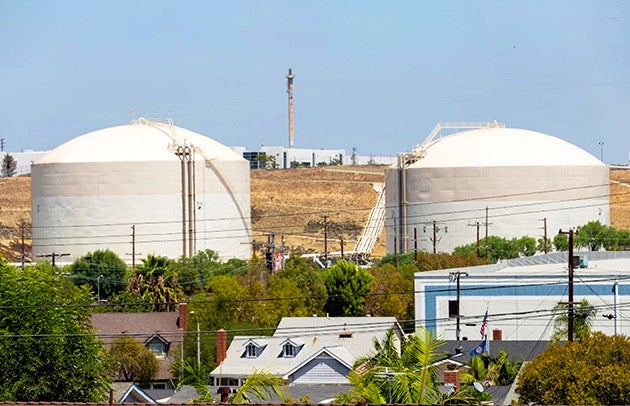
Students tackle urgent environmental issues thanks to a new fellowship program
Just a few blocks from a busy Target store, preschool and neighborhood of single-family homes in San Pedro, California, sit two tanks containing nearly 25 million gallons of butane gas. If a spill were to occur, a single spark could ignite the highly combustible gas and detonate a massive explosion.
Nearby residents have been unsuccessfully petitioning for the removal of the tanks since their installation in the 1970s. Now, USC Dornsife College of Letters, Arts and Sciences biological sciences major Tim Saunders is joining the fight, thanks to an Environmental Health Methodological, Trainings and Teaching Enterprise (EH MATTERS) fellowship provided by the USC Environmental Health Centers.
Under the guidance of Edward Avol, professor of clinical population and public health sciences at the Keck School of Medicine of USC, Saunders is building a case study of the tanks’ impact on the neighborhood.

Saunders is detailing the risks from large tanks of highly flammable butane gas situated near homes and schools in San Pedro. (Image Source: Google Maps/Chris Valle.)
“I did calculations, based on an Environmental Protection Agency formula, for the distance broken glass could spray and people will be injured. Best case scenario, the blast radius would be around three miles. The port of Los Angeles would be damaged,” says Saunders. “Then there’s the worst-case scenario. If you look at a maximum impact range, it could be up to around 10 ½ miles.”
He’s working on a website and infographics that visualize the danger in the hopes it gets policy-makers to act.
Ensuring environmental equity
Saunders is one of seven students currently using an EH MATTERS fellowship to research environmental issues that affect human health and safety. The paid, three-semester opportunity pairs students with a mentor who assigns a project and provides guidance for their work.
The fellowship is led by Avol, Jill Johnston, assistant professor of preventive medicine at Keck School of Medicine and spatial sciences at USC Dornsife, and Wendy Gutschow, program administrator in the Division of Environmental Health, Department of Population and Public Health Sciences at the medical school.
Funded by the National Institute of Environmental Health Sciences, the fellowship aims to mentor students from backgrounds underrepresented in the sciences. The program’s application includes considerations like racial ethnicity, whether an applicant is a first-generation college student or an immigrant.
“I find that equity and diversity discussions are often too narrowly focused on race or income in isolation, when in fact cultures, traditions and beliefs are also a big part of the conversation — and this program was designed with that in mind,” says Rima Habre, associate professor of (clinical) environmental health and spatial sciences at Keck School of Medicine and USC Dornsife.
Up in the air
The EH MATTERS fellowship is enabling Leon Zha, a quantitative biology major, to act on long-standing concerns for the environment. Zha grew up in the Bay Area, where California’s seasonal wildfires were at first only a background annoyance. Starting around his sophomore year in high school, however, the fires became so large and the wildfire smoke so stifling that his cross country and track practices were often canceled.
Zha joined his high school environmental club, which conducted clean-ups of creek beds, lobbied the city council to enact stricter environmental regulations and installed compost bins in the school.
He also got involved with the landmark Juliana vs. United States case, in which 21 young people sued the federal government for inaction on climate change. An essay written by Zha, detailing the impact of the wildfires on his life, was submitted to the appeals court as part of the case.
Now through his EH MATTERS fellowship, he’s working with Habre on the issue of air pollution. Zha has been analyzing particulate matter measurements in the air around L.A. and determining its sources.
“Leon’s models will help investigators in the Maternal and Developmental Risks from Environmental Social Stressors Center understand which sources of exposure during pregnancy are most responsible for higher health risks in the mom and the baby,” says Habre.
Friends and neighbors
Zha is happy that his work could make a palpable difference to people. “It’s no use if we’re just in some ‘ivory tower’ all day,” he says. “Ultimately, we want our science to be impactful for the community around us.”
Many environmental health issues are hurting low-income communities the most. Studies indicate that those living in poor neighborhoods breathe in more hazardous particles and drink more contaminated water. Communities that are home predominantly to people of color and immigrants are also most likely to be affected.
The EH MATTERS fellowship enables students from affected groups and neighborhoods to conduct research that could make a difference in their own backyard.
“Being a man of color, EH MATTERS gave me a platform to speak for my community,” says Saunders.